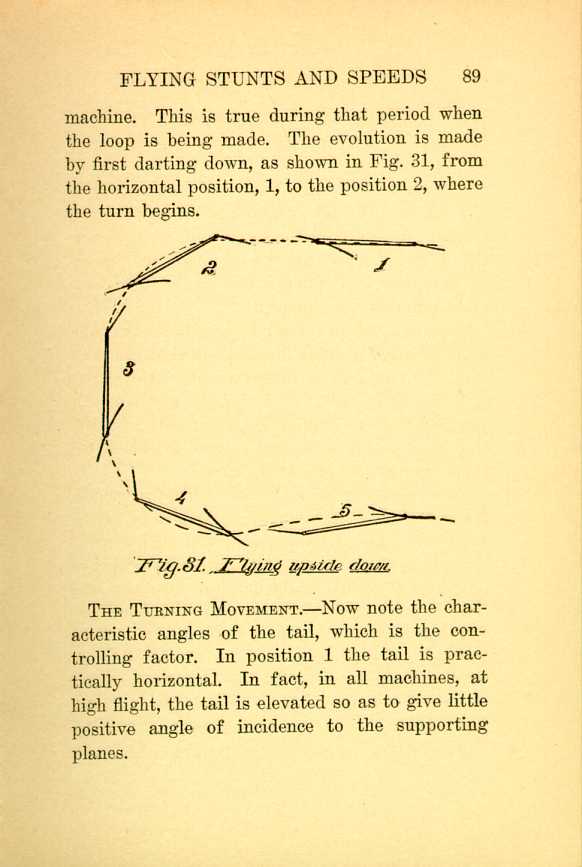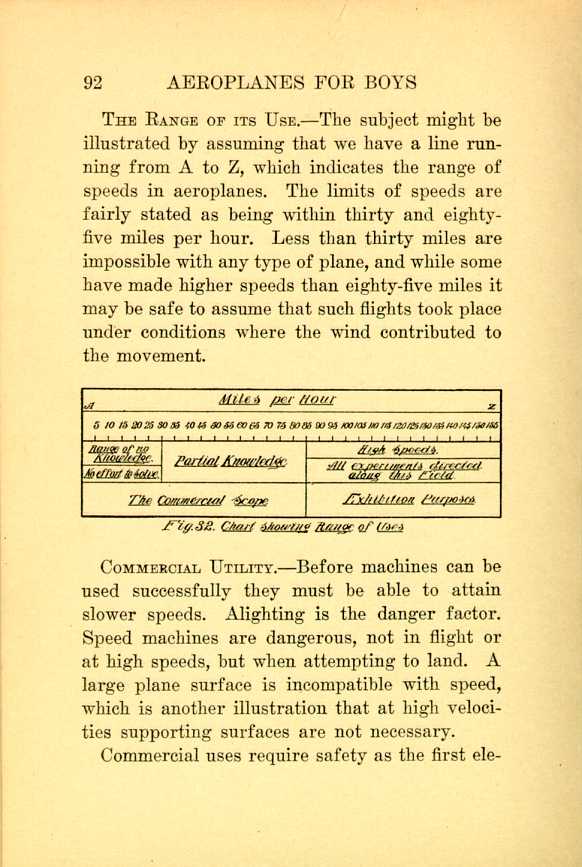| CHAPTER VII
ABNORMAL FLYING STUNTS AND SPEEDS Aeroplanes | ||
7. CHAPTER VII
ABNORMAL FLYING STUNTS AND SPEEDS
"PEQUOD, a Frenchman, yesterday repeatedly performed the remarkable feat of flying with the machine upside down. This exhibition shows that the age of perfection has arrived in flying machines, and that stability is an accomplished fact."—News item.
This is quoted to show how little the general public knows of the subject of aviation. It correctly represents the achievement of the aviator, and it probably voiced the sentiment of many scientific men, as well as of the great majority of aviators.
A few days afterwards, the same newspaper published the following:
"Lieutenant —, while experimenting yesterday morning, met his death by the overturning of his machine at an altitude of 300 meters. Death was instantaneous, and the machine was completely destroyed."
The machines used by the two men were of the same manufacture, as Pequod used a stock machine which was strongly braced to support the inverted weight, but otherwise it was not unlike the well known type of monoplane.
Beachy has since repeated the experiment with a bi-plane, and it is a feat which has many imitators, and while those remarkable exhibitions are going on, one catastrophe follows the other with the same regularity as in the past.
Let us consider this phase of flying. Are they of any value, and wherein do they teach anything that may be utilized,
LACK OF IMPROVEMENTS IN MACHINES.—It is remarkable that not one single forward step has been taken to improve the type of flying machines for the past five years. They possess the same shape, their stabilizing qualities and mechanism for assuring stability are still the same.
MEN EXPEDITED, AND NOT THE MACHINE.—The fact is, that during this period the man has been exploited and not the machine. Men have learned, some few of them, to perform peculiar stunts, such as looping the loop, the side glide, the drop, and other features, which look, and are, hazardous, all of which pander to the sentiments of the spectators.
ABNORMAL FLYING OF NO VALUE.—It would be too broad an assertion to say that it has absolutely no value, because everything has its use in a certain sense, but if we are to judge from the progress of inventions in other directions, such exhibitions will not improve the art of building the device, or make a fool-proof machine.
Indeed, it is the very thing which serves as a deterrent, rather than an incentive. If machines can be handled in such a remarkable manner, they must be, indeed, perfect! Nothing more is needed! They must represent the highest structural type of mechanism!
That is the idea sought to be conveyed in the first paragraph quoted. It is pernicious, instead of praiseworthy, because it gives a false impression, and it is remarkable that even certain scientific journals have gravely discussed the perfected (?) type of flying machine as demonstrated by the experiments alluded to.
THE ART OF JUGGLING.—We may, occasionally, see a cyclist who understands the art of balancing so well that he can, with ease, ride a machine which has only a single wheel; or he can, with a stock bicycle, ride it in every conceivable attitude, and make it perform all sorts of feats.
It merely shows that man has become an expert
PRACTICAL USES THE BEST TEST.—The bicycle did not require such displays to bring it to perfection. It has been the history of every invention that improvements were brought about, not by abnormal experiments, but by practical uses and by normal developments.
The ability of an aviator to fly with the machine in an inverted position is no test of the machine's stability, nor does it in any manner prove that it is correctly built. It is simply and solely a juggling feat—something in the capacity of a certain man to perform, and attract attention because they are out of the ordinary.
CONCAVED AND CONVEX PLANES:—They were performed as exhibition features, and intended as such, and none of the exponents of that kind of flying have the effrontery to claim that they prove anything of value in the machine itself, except that it incidentally has destroyed the largely vaunted claim that concaved wings for supporting surfaces are necessary.
HOW MOMENTUM IS A FACTOR IN INVERTED FLYING.—When flying "upside down," the convex side of the plane takes the pressure of the air, and maintains, so it is asserted, the weight of the

Fig. 31. Flying upside down.
[Description: Black and white illustration: a technical diagram.]TURNING MOVEMENT.—Now note the characteristic angles of the tail, which is the controlling factor. In position 1 the tail is practically horizontal. In fact, in all machines, at high flight, the tail is elevated so as to give little positive angle of incidence to the supporting planes.
In position No. 2, the tail is turned to an angle of incidence to make the downward plunge, and when the machine has assumed the vertical, as in position 3, the tail is again reversed to assume the angle, as in 1, when flying horizontally.
At the lower turn, position 4, the tail is turned similar to the angle of position 2, which throws the rear end of the machine down, and as the horizontal line of flight is resumed, in an inverted position, as in position 4, the tail has the same angle, with relation to the frame, as the supporting planes.
During this evolution the engine is running, and the downward plunge develops a tremendous speed, and the great momentum thus acquired, together with the pulling power of the propeller while thus in flight, is sufficient to propel it along horizontally, whatever the plane surface curve, or formation may be.
It is the momentum which sustains it in space, not the air pressure beneath the wings, for reasons which we have heretofore explained. Flights of sufficient duration have thus been made to prove that convex, as well as concave surfaces are efficient; nevertheless, in its proper place we have given an exposition of the reasoning which led to the adoption of the concaved supporting surfaces.
WHEN CONCAVED PLANES ARE DESIRABLE.—Unquestionably, for slow speeds the concaved wing is desirable, as will be explained, but for high speeds, surface formation has no value. That is shown by Pequod's feat.
THE SPEED MANIA.—This is a type of mania which pervades every field of activity in the building of aeroplanes. Speed contests are of more importance to the spectators on exhibition grounds than stability or durability. Builders pander to this, hence machines are built on lines which disregard every consideration of safety while at normal flight.
USES OF FLYING MACHINES.—The machine as now constructed is of little use commercially. Within certain limitations it is valuable for scouting purposes, and attempts have been made to use it commercially. But the unreliable character of its performances, due to the many elements which are necessary to its proper working, have operated against it.
PERFECTION IN MACHINES MUST COME BEFORE SPEED.—Contrary to every precept in the building of a new article, the attempt is made to make a machine with high speed, which, in the very nature of things, operates against its improvement. The opposite lack of speed—is of far greater utility at this stage of its development.
THE RANGE OF ITS USE.—The subject might be
illustrated by assuming that we have a line running
from A to Z, which indicates the range of
speeds in aeroplanes. The limits of speeds are
fairly stated as being within thirty and eighty-five miles per hour. Less than thirty miles are
impossible with any type of plane, and while some
have made higher speeds than eighty-five miles it
may be safe to assume that such flights took place
under conditions where the wind contributed to
the movement.

Fig. 32. Chart showing Range of Uses
[Description: Black and white illustration: a technical chart.]
COMMERCIAL UTILITY.—Before machines can be used successfully they must be able to attain slower speeds. Alighting is the danger factor. Speed machines are dangerous, not in flight or at high speeds, but when attempting to land. A large plane surface is incompatible with speed, which is another illustration that at high velocities supporting surfaces are not necessary.
Commercial uses require safety as the first element,
How few are the attempts to solve the problem of decreased speed, and what an eager, restless campaign is being waged to go faster and faster, and the addition of every mile above the record is hailed as another illustration of the perfection (?) of the flying machine.
To be able to navigate a machine at ten, or fifteen miles an hour, would scarcely be interesting enough to merit a paragraph; but such an accomplishment would be of far more value than all of Pequod's feats, and be more far-reaching in its effects than a flight of two hundred miles per hour.
| CHAPTER VII
ABNORMAL FLYING STUNTS AND SPEEDS Aeroplanes | ||